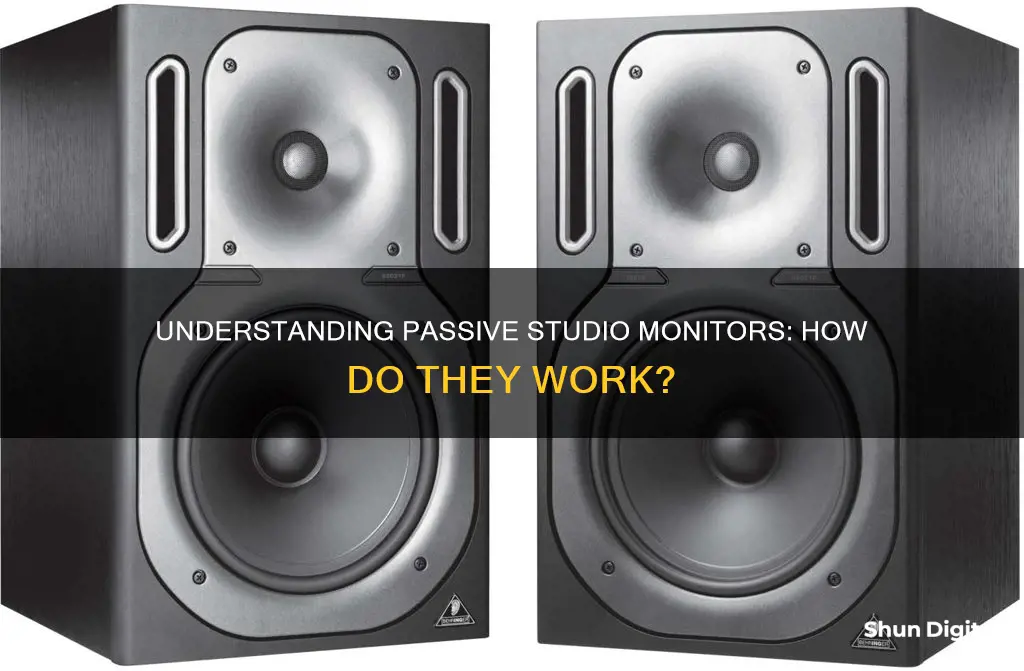
Passive studio monitors are speakers that require an external power amplifier to function. They are typically lighter and easier to mount than active monitors, and they offer more customisability, allowing users to mix and match speakers and amplifiers to achieve their desired performance characteristics. Passive monitors are also more affordable than active monitors, making them a popular choice for those on a budget. However, they may require more complex setup processes and additional equipment, such as speaker cables and amplifiers.
Characteristics of Passive Studio Monitors
| Characteristics | Values |
|---|---|
| Power Supply | Require an external power supply |
| Amplifier | Require an external amplifier |
| Weight | Lighter |
| Cabling | Only require a standard speaker cable |
| Customisability | Allow for custom amplifier pairing |
| Upgradeability | Speakers and amplifiers can be upgraded separately |
| Components | Can benefit from adding a subwoofer |
| Cost | Less expensive upfront |
| Mounting | Easier to mount |
What You'll Learn

Passive monitors are more affordable and convenient than active monitors
Passive studio monitors are more affordable and convenient than active monitors.
Passive monitors are more affordable because they allow for separate upgrades of the two components of a monitoring system: the speakers and the amplifier. This means that you can upgrade your equipment gradually and in a more cost-effective manner, rather than having to replace the entire system at once. This also gives you the freedom to create your ideal signal chain by choosing your own amplifier, crossover system, and other processing equipment.
Passive monitors are also more convenient for certain use cases, such as multichannel surround and immersive monitoring setups. Because passive monitors are lightweight and only require one cable, they are easy to mount on walls and ceilings. Additionally, you can turn them all on or off at once via the amplifier, instead of having to flip a switch on each speaker.
Passive monitors are also advantageous when it comes to consistency. Since factors like temperature, humidity, and power fluctuations can cause amplifiers to perform differently, it is better to have one or two amplifiers than one in each speaker. This ensures that all your speakers are performing consistently, which is crucial in critical listening disciplines like mastering.
Furthermore, passive monitors make it easier to expand your setup as your studio grows. You can start with a basic stereo pair of monitors and a four-channel amplifier, and then gradually add more speakers and amplifier channels as needed. This modular approach can be more affordable than investing in multiple active monitors upfront.
While active monitors offer their own set of advantages, passive monitors provide flexibility, affordability, and convenience, making them a popular choice for many professionals in the audio industry.
Autosync Monitor Size: Easy Steps for Quick Display Scaling
You may want to see also

Passive monitors are lighter and easier to mount
Passive studio monitors are lighter and easier to mount than active monitors. This is because they do not contain a built-in amplifier, which makes them more lightweight and flexible in terms of placement. They can be easily mounted on walls and hung from ceilings, which is often not possible with active monitors due to their weight.
The absence of an internal amplifier in passive monitors means they only require a standard speaker cable, whereas active monitors need both a power cable and an audio cable. This makes passive monitors more convenient and straightforward to set up in a studio environment.
Passive monitors provide users with the freedom to customise their setup by choosing their own amplifier, crossover system, and other processing equipment. This flexibility allows for a tailored approach to sound optimisation and the creation of an ideal signal chain.
While passive monitors offer customisability and lightweight design, they may require more time for research, planning, and installation. This trade-off between convenience and flexibility is an essential consideration when choosing between active and passive studio monitors.
Ultimately, the decision between active and passive monitors depends on individual preferences, budget constraints, and specific use cases. Both options can deliver professional-quality sound, but passive monitors offer greater flexibility in terms of weight, mounting options, and customisability.
Connect Instruments to Alto TX210: A Beginner's Guide
You may want to see also

Passive monitors require an external amplifier
Passive studio monitors require an external amplifier to function. This is the key difference between active and passive speakers. Active speakers feature onboard amplifiers built into the cabinet, whereas passive models require an external power source. This distinction impacts several factors, giving each type of speaker a variety of pros and cons.
Passive monitors are lighter and easier to mount than active monitors, and they only require a standard speaker cable. This makes them a more obvious choice for studios. They also give users the freedom to create their ideal signal chain by choosing their own amplifier, crossover system, and other processing. However, setting up passive monitors requires more research, planning, and installation time.
Passive monitors are also a good choice for those who want to be able to customise their signal chain. Users can try out different amplifiers, crossovers, speaker cables, and processors to find the best combination for their setup. Passive monitors are also advantageous for consistency. Because factors like temperature, humidity, and power fluctuations can cause amplifiers to perform differently, it's better to have one or two amplifiers than one in each speaker.
Passive monitors are also a good option for those who want to expand their setup as their studio grows. For example, users can start with a stereo pair of monitors and a four-channel amp, then add a second pair of reference monitors later on. Upgrading to a six-channel amp will allow for a 5.1 system, and more speakers and amp channels can be added as needed for larger setups.
In the end, the decision to use active or passive speakers is a personal one, as there are benefits to both approaches. Passive systems have an advantage when it comes to flexibility, but active monitors have the benefit of being quick and easy to set up.
Removing the Base from Your DellSE2216H Monitor: A Step-by-Step Guide
You may want to see also

Passive monitors allow for customisation and upgrades
Passive studio monitors offer a high degree of customisation and flexibility, allowing users to tailor their sound system to their unique needs and preferences. This is achieved through the use of external amplifiers, which can be selected and upgraded independently of the speakers. This modular approach has several benefits.
Firstly, it enables users to choose an amplifier that best suits their specific requirements, whether that's based on power rating, impedance, sound quality, or a combination of factors. This freedom to mix and match amplifiers and speakers empowers users to create a setup that perfectly aligns with their studio environment, music style, and personal tastes.
Secondly, the ability to upgrade the amplifier separately from the speakers offers a more gradual and cost-effective path to improving the overall sound quality of the system. Users can start with affordable passive monitors and a basic amplifier, then upgrade each component independently as their needs evolve and their budget allows. This upgradeability also extends the lifespan of the equipment, as individual components can be replaced or enhanced without having to replace the entire system.
Additionally, passive monitors are often more lightweight and easier to mount than their active counterparts, providing more flexibility in terms of placement and setup. They only require a standard speaker cable, reducing cable clutter and making them ideal for multichannel surround and immersive monitoring setups.
While passive monitors offer customisation and upgradeability, it's important to note that they may require more research, planning, and installation time upfront. The process of selecting compatible amplifiers, crossovers, and other components can be more complex than the plug-and-play convenience offered by active monitors.
Is Your Monitor Mirrored? Check with These Steps
You may want to see also

Passive monitors are ideal for surround and immersive monitoring setups
Passive studio monitors are ideal for surround and immersive monitoring setups. While 5.1 and 7.1 are the longtime standards for film and TV mixing, setups like 5.1.4 and 7.1.4 are becoming more common with the rise of spatial audio formats like Dolby Atmos. Passive monitors are perfect for such setups because they are lightweight and require only one cable, making them easy to mount on walls and hang from ceilings. They can also be turned on or off simultaneously via the amplifier, instead of having to flip a switch on each speaker.
Passive monitors also offer more flexibility. They are usually lighter and easier to mount than active monitors, which require a power cable in addition to an audio cable. Passive monitors only require a standard speaker cable, and they are less likely to overload a small space because they don't output as much bass. This makes them a good choice for smaller studios.
Passive monitors also give you the freedom to create your ideal signal chain. You can choose your own amplifier, crossover system, and other processing equipment to get the best performance for your setup. You can also easily expand your setup as your studio grows. For example, you can start with a stereo pair of monitors and a four-channel amp, then add a second pair of reference monitors and upgrade to a six-channel amp for a 5.1 system. This modular approach can be more affordable than investing in active monitors, and it allows you to upgrade components one at a time.
Passive monitors are also a good choice if you want to be able to customise your setup over time. You can start with a reasonable amp and upgrade to a better one later, or vice versa. This makes it easier to gradually improve your system without having to take large financial steps.
How to Position Studio Monitors for Optimal Sound
You may want to see also
Frequently asked questions
Active studio monitors generally provide a more accurate frequency response and improved sound quality because the built-in amplifiers are specifically tuned for the drivers they power. Passive monitors can also deliver high-quality sound, but this depends on the external amplifier’s compatibility with the speakers.
Choosing between active and passive monitors for your home studio depends on factors such as budget, space, and customizability. Active monitors are often more cost-effective as they don’t require the purchase of an external amplifier. They also save space, as they contain their own amplifiers. Passive monitors, on the other hand, allow you to mix and match amplifiers and speakers.
Active monitors offer the convenience of an all-in-one system and less equipment, and they are often more reliable. However, they are less customizable and can be more complex to repair. Passive monitors allow for custom amplifier pairing and the ability to upgrade components separately, but they require more space and may end up costing more due to the need for additional equipment.
Active monitors include built-in amplification, creating a tailored audio system within a single unit. Passive monitors require an external amplifier, which means ensuring the amplifier matches the monitor’s power needs for optimal performance.







